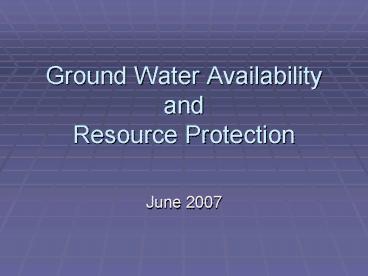Ground Water Availability and Resource Protection
1 / 17
Title:
Ground Water Availability and Resource Protection
Description:
Sole Source Aquifer - no significant fresh water streams or rivers ... A confined aquifer is one that is under pressure (the water surface is higher ... –
Number of Views:27
Avg rating:3.0/5.0
Title: Ground Water Availability and Resource Protection
1
Ground Water AvailabilityandResource Protection
- June 2007
2
General Water Supply Issues
- Sole Source Aquifer - no significant fresh water
streams or rivers - Limited resource - recharge occurs in a Spine
Area - Fresh ground water is restricted to depths less
than 350 feet - Multiple contamination threats - to the water
table from land use activities and to the
confined aquifers from over pumping - Most likely cause for a loss of fresh ground
water is salt water intrusion due to over pumping
3
What is an Aquifer
- Any coarse grained material (sand, gravel) that
can supply sufficient water for a beneficial use - A confined aquifer is one that is under pressure
(the water surface is higher than the physical
top of the aquifer) - An unconfined or water table aquifer is the
closest to the surface and is not under pressure
What is a Confining Unit
- Any fine grained material (silt, clay) that can
significantly restrict vertical movement of
groundwater such that the underlying groundwater
is under pressure.
4
Schematic Cross-Section of Freshwater Lens
WEST
Water Table Surface
Confining Unit
Freshwater Aquifer
Saltwater Aquifer
Estimated Recharge to Water Table Aquifer 625
MGD approx Estimated Recharge to
Yorktown-Eastover Aquifer 8 MGD approx
5
Water Budget for the Water Table Aquifer
Total Estimated Recharge to Water Table Aquifer
625 MGD
6
Permitted Groundwater Withdrawals
7
Total Water Budget in the Confined Aquifer
Public/Industrial pumping domestic pumping Is
equal to Water Leaking through upper confining
unit water released from storage
8
Groundwater Level Trends Near Perdue
9
Recharge to Yorktown-Eastover is Limited
- USGS collected water samples collected from wells
and age dated them - Much of the water table aquifer was less than
50-years old. - In contrast, average age for water samples from
the upper Yorktown-Eastover exceeds 1,000 years
10
Rate of Flow Through Upper Confining Unit
11
Schematic Cross-Section of Freshwater/Saltwater
Interface
12
Increasing Chloride Trends Over TimeTown of
Chincoteague Well
13
Cape Charles Chloride Levels Near Production
Wells
14
Chloride Increase With DepthUpshur Neck Seaside
Example
Fresh Ground Water
Brackish Ground Water
15
Available Water Evaluations
- Previous Used Tools
- Empirical Observations
- Analytical models / calculations
- Numeric Models USGS SHARP Model EPA FEMWATER
models - Current Tool
- USGS Eastern Shore Model (SEAWAT)
16
USGS SEAWAT Model
- Beta Version
- Major Enhancements
- Increased resolution
- minimum horizontal size 1,000x1,000 Feet from
original 1-mile - Vertical layers increased from original 4 to 46.
- Functional Water Table
- Increased lateral extent into Maryland
- Ability to simulate gradational increase in
saltwater - Calibrated from 1920 through 2003 at 20
observation points
17
Three Dimensional Grid































